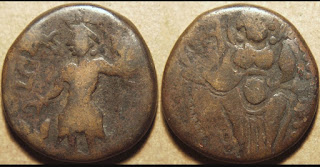The nomadic tribes who lived in the neighbourhood of China were the Hephthalites (the Sanskrit name of which is Hunas). The Hunas are thought to have included the Xionite and /or Hephthalite, the Kidarites, the Alchon Huns and the Nezak Huns. The Hunas extended their kingdom from the border of Persia to Khotan in Central Asia. There were two branches of Hunas that advanced towards the west. One branch of the Hunas moved towards the Roman Empire and the other towards India. The invasion of India by the Hunas began about a hundred years after the Kushanas' invasion. The sixth century Roman historian Procopius of Caesarea (Book 1, Ch. 3) refers them as White Huns, who invaded Northwest India.
Toramana Coin, early 6th century.
The Gupta Empire in India reigned in the Ganges basin during the fifth century, and the Kushan dynasty occupied the area along the Indus. After defeating the Kushans, the Hunas entered the subcontinent from the Kabul valley. This was in 458 AD. The Hephthalites, (Hunas) kept on invading India until the Gupta ruler Skandagupta repulsed them. The Hunas under the leadership of Toramana, suffered a crushing defeat by the Gupta emperor Skandagupta.
Before the defeat of the Hunas, they had displaced the Gupta Empire rule from the Northwestern part of India and ruled over Gandhar and central Punjab and also controlled the Kushans. He reduced the power of a number of local kings and chieftains and assumed the title of '' Maharajadhiraja''. In many regions of Sutlej and Yamuna, coins and inscriptions of Toramana were found.
The Hunas waited till the death of Skandagupta to invade again in 470 AD. This time under Mihirakula, the successor of Toramana, the Hunas were successful temporarily and ruled from Sakal, today's Sialkot. Mihirakula ruled over Northwestern India for thirty years. They persecuted Buddhists and destroyed all monasteries.
However, Mihirakula was defeated by two major rulers Yasodharman
and Narasimhagupta Balditya and was driven out of the plains and into Kashmir and died in about 542 AD. After his death, the political power of Hunas declined and they were driven out of India.
The trade connections between the Guptas and the Roman Empire weakened after the Hunas invasion. Cultural cities like Pataliputra and Ujjain lost their glory. Small kingdoms began to grow and prosper on the ruins of the Gupta Empire hereafter. It is widely believed that for the first time there was a racial admixture in India after the Huna invasion and the Indian culture got introduced to the Huna's martial culture.
Coins of Hunas. They were essentially of three types. The large copper coins portray the king riding a horse on the obverse and Lakshmi on the reverse side. These were copied from the Gupta horseman type. The second type followed the coins of Later Kushans. The third type were the Sassanian type with the kings bust on the obverse and a humped bull on the reverse.
Mihirakula, 515-540 AD, Drachm, weight 2.6gm, Dia 25 mm, Obverse: Crowned bust of emperor, right, filleted scepter surmounted by round plate behind, filleted trident, Reverse; Fire altar with attendants, scepter and trident in opposite fields.
Mihirakula, copper, stater, 515-540 AD, weight 7.6 gm, Dia 22 mm, Obverse: Kushan style king standing sacrificing at altar left and holding a standard, with Brahmi legend, Reverse: Goddess Ardoksho seated facing on throne, holding filleted diadem and cornucopia.
Mihirakula, early 6th century, weight 7.2 gm, Dia 20mm, Obverse: Kushan style king standing, facing, holding scepter in left hand, right hand sacrificing at fire altar left, Brahmi legend left: shahi mihi, right: ragula Reverse: Goddess of plenty Ardochsho (Lakshmi) enthroned facing, holding cornucopia and diadem.
















No comments:
Post a Comment
Any inputs or feedback is welcome!